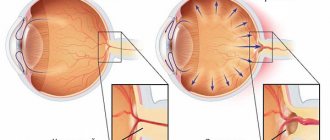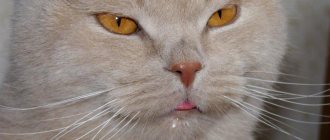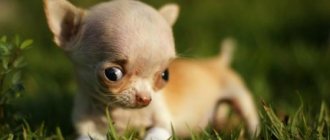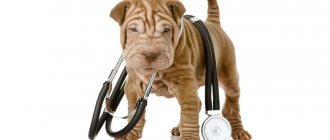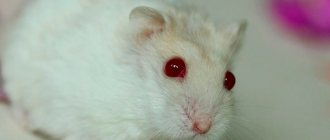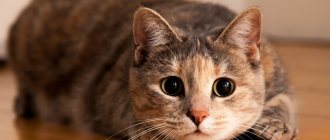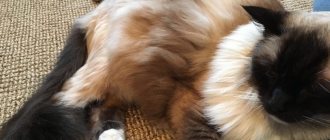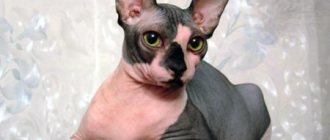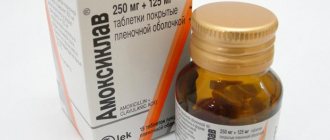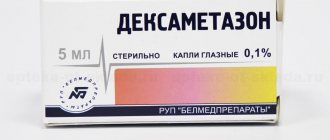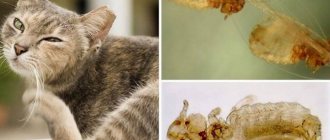Reasons for the development of glaucoma in animals
The physiological norm of pressure in the chamber of the eye is from 15 to 25 mm. Hg Art. This indicator ensures the normal functioning of the drainage system of the visual organs in animals. Being a complex pathology, glaucoma in a pet is characterized not only by an increase in intraocular pressure, but also by destruction of the optic nerve and destruction processes in the retina.
When intraocular pressure increases to critical values, an increase in the size of the eyeball occurs, atrophy of the optic nerve and, as a result, blindness.
Veterinary experts consider the following unfavorable factors to be the causes of the development of eye disease:
- Congenital developmental pathologies . An abnormal structure of the eye drainage system can lead to ophthalmological disease.
- Chronic eye diseases : uveitis and conjunctivitis of various etiologies, lens luxation, neoplasms in the visual tissues are a common cause of the development of the disease. Treatment of eye pathologies with corticosteroid drugs increases the risk of the animal developing increased intraocular pressure.
- Injuries to the eyes, skull . Mechanical damage to the tissues of the visual apparatus often provokes various dysfunctions of the drainage system of the eye.
- Genetic predisposition . Breeders and veterinarians note that heredity plays a primary role in the etiology of ophthalmological diseases. The risk of developing glaucoma in offspring born from sick parents increases 3-4 times.
- Accompanying illnesses. The cause of the disease is often diabetes mellitus. High concentrations of sugar in the blood cause not only increased blood pressure in the body, but also an increase in its levels in the eye chamber. There are frequent cases of the development of eye pathology in obesity.
- Senile changes in the organs of vision are inevitably accompanied by the development of destructive processes in the trabecular system of the anterior chamber of the corner of the eye.
- A number of experts believe that the cause of increased pressure in the visual chamber is long-term use of steroidal anti-inflammatory drugs, as well as hormonal drugs . Steroid drugs and sex hormones activate the synthesis of proteins and lipomucopolysaccharides, which settle in the outflow system of intraocular fluid, thereby increasing pressure.
- Hypertension in an animal . Arterial hypertension, according to many doctors, often leads to the development of glaucoma in domestic cats.
Veterinary experts note that a factor contributing to the development of pathology is the breed of the furry pet. In cats of such breeds as Siamese, Persian, Burmese, and European Shorthair, glaucoma is diagnosed much more often than in other representatives.
We recommend reading about conjunctivitis in dogs and cats. You will learn about the causes of conjunctivitis, its forms, diagnosis and treatment in your pet. And here is more information about the treatment of discharge from the eyes of a cat.
How to treat?
Therapy depends on the cause of the disease. The goal of the therapeutic course is to stop the development of glaucoma and restore normal fundus pressure. Treatment of glaucoma in cats is carried out on both organs at once, even if only one of them is affected. To remove inflammatory processes, diuretics (Mannitol) are prescribed. Bimatoprost or Amlodipine help with uveitis and stagnation of ocular fluid. To reduce blood pressure, beta blockers are used: Temolol or Betoxol.
Vitamin complexes will help compensate for the lack of useful microelements.
In addition, the following groups of drugs are used:
- vitamins;
- anti-inflammatory;
- antibiotics;
- antispasmodics.
Drug treatments help stop the disease only in the first stages. At the last stages, surgical intervention is used: drainage of the anterior chambers of the visual apparatus or removal of the ciliary body. It is also possible to treat glaucoma with a laser. This method is painless and effectively eliminates pathology. If therapy is not possible, then the diseased organ is completely excised. This helps the cat get rid of constant spasms.
Symptoms of glaucoma in cats
Taking into account the insidious nature of ophthalmopathy and the negative consequences for the health and quality of life of the animal, the owner should have an understanding of the clinical signs of a developing pathology:
- Eye hyperemia . Redness is one of the first signs of the development of an ophthalmic disease. The symptom is associated with the development of episcleral edema. Due to the expansion of capillaries, the eyeball becomes red.
- Swelling of the eyelids, their loose closure.
- Mydriaz . An attentive owner can observe a constant dilation of the pupil. There is practically no reaction to light.
- Increased tear production . There are traces of tear fluid in the corners of the eyes and on the sides of the nose.
- The cornea of the eye becomes cloudy and loses sensitivity.
- Buphthalmia . An increase in the size of the eyeball occurs due to overstretching of collagen fibers in the sclera and cornea.
- Photophobia . The animal avoids bright lighting and spends most of its time in the dark.
- The general condition of the sick pet worsens . There is a loss of appetite, a lethargic and depressed state. This is because ophthalmopathy causes severe pain. The cat is poorly oriented in space and has difficulty jumping onto elevated surfaces. The animal avoids games. Does not respond to movement of the laser pointer.
The symptoms of the disease depend on the stage of development of the ophthalmological disease and its type. An acute attack is accompanied by severe pain, vomiting, and weakness. If such clinical signs are detected, the owner should take the pet to a veterinarian.
Types of glaucoma in cats
Being a serious ocular pathology, glaucoma has a complex classification based on the etiology and condition of the iridocorneal angle.
Primary and secondary
Based on the etiological factor, primary and secondary forms of ophthalmological disease are distinguished. In primary glaucoma, no concomitant disease is diagnosed. As a rule, the cause of the disease is a genetically determined deviation in the drainage system of the eye. This form of the disease is extremely rare in cats and is observed in both eyes.
In secondary glaucoma, the causes are eye diseases, for example, uveitis, lens luxation, malignant neoplasm. When the underlying disease is eliminated, secondary glaucoma is treatable. This form of the disease is diagnosed in cats older than 8-9 years.
Congenital
This type of ophthalmopathy is the rarest in cats and is usually observed in representatives of the Siamese breed. Veterinary experts believe that the cause of the disease is congenital degenerative damage to the outflow system of intraocular fluid. Damage to the trabecular apparatus of the angle of the anterior chamber of the eye develops at the stage of intrauterine development.
Congenital glaucoma in a kitten
Open angle
Based on the state of the iridocorneal angle, veterinary specialists distinguish between open-angle and closed-angle forms of pathology. In the first case, glaucoma is not accompanied by a narrowing of the iridocorneal angle. The outflow of intraocular fluid is obstructed from the posterior chamber of the eye. The optic nerve dies and vision is lost.
Closed angle
This form of glaucoma occurs when the iridocorneal angle is blocked. This situation occurs when inflammatory reaction products accumulate in the drainage system and neoplasms develop. This type of disease is rare in cats.
Videos and illustrations
Glaucoma in dogs and cats
Structure of a cat's eye
Congenital glaucoma
Mydriasis (dilation of the pupil) and its glow in glaucoma
Mydriasis with glaucoma in cats
Uveitis
Diagnosis of glaucoma in cats
A professional ophthalmological examination will allow you to establish an accurate diagnosis. For this purpose, the veterinarian will not only visually examine the furry patient, but will also use special research methods - tonometry, gonioscopy.
At the first stages of diagnosis, a slit lamp examination and ophthalmoscopy are performed. The most informative method is measuring intraocular pressure.
Tonometry allows you to determine the parameters and assess the condition of the drainage system of the eye. Measurements are made using a Maklakov tonometer and a Polyak ruler. The indicator is measured twice. For readings above 50 mm. Hg Art. there is no doubt about the diagnosis.
Gonioscopy is performed using Goldmann and Van Beuningen mirror ophthalmoscopes. The method allows you to examine the angle of the anterior chamber, the ciliary body and peripheral segments of the retina. The examination is carried out under local anesthesia.
If a pathology of the postorbital space is suspected, a veterinary specialist will prescribe an ultrasound diagnosis of the eye. This method allows you to identify neoplasms and retinal detachment.
An important place is occupied by differential diagnosis from other ophthalmological pathologies, for example, acute iridocyclitis, ulcerative keratitis, corneal endothelial dystrophy.
Surgery
Unfortunately, nothing will help restore lost vision, but this does not mean that you do not have to deal with the accompanying symptoms. If the animal's health deteriorates significantly, surgery is performed to remove the affected eye. This will relieve him of constant pain and discomfort.
If vision has not yet begun to decline, then during surgery the surgeon either partially removes the ciliary body or drains the anterior chamber. This will help normalize intraocular pressure for a while.
Treatment of glaucoma in cats
The therapeutic strategy for ophthalmopathy depends on the type and form of the disease. In veterinary practice, both conservative and surgical treatment methods are used.
Emergency care for open-angle glaucoma
The acute form of glaucoma requires immediate professional help. Emergency therapy is aimed primarily at reducing intraocular pressure. For this purpose, miotics, diuretics, hyperosmotic drugs, and beta-blockers are used.
Drug treatment
Therapy for glaucoma is aimed at reducing intraocular pressure, activating the fluid outflow system, and reducing the volume of the eyeball.
In order to normalize the drainage system of the visual organs, Mannitol, Timolol, and Dichlorphenamide are used.
Among the miotics that promote pupil constriction, the following are used in veterinary practice: Pilocarpine, Phospholin, Humorsol, Physostigmine. In the event that a complication in the form of uveitis is observed, miotics are not used. Corticosteroids may be used for treatment. Carbonic anhydrase inhibitors, which have a kaliuretic effect, have a good effect.
Some clinics practice treatment of glaucoma with liquid nitrogen and retrobulbar administration of alcohol.
Laser eye treatment for cats
Unfortunately, conservative treatment methods do not give the desired effect. Modern veterinary medicine has a wide arsenal of surgical treatment methods, including laser therapy. Cyclophotocoagulation allows you to solve the problem without bloodshed, reducing the rehabilitation period. The disadvantage of the modern method is the high price and availability of a specialized clinic.
Surgical treatment of glaucoma, its features and options
An experienced ophthalmologist successfully performs bypass surgery of the anterior chamber of the eye. Often, surgery is used as a surgical treatment to reduce the formation of intraocular fluid. The most widely used methods are cyclocryotherapy and cyclodiathermy.
In the event that the chances of returning vision are small, they resort to installing an intraocular prosthesis (evisceration). In advanced cases, removal (enucleation) of the eyeball is performed.
Treatment with folk remedies: reviews from owners
In the comments, cat owners often ask about folk remedies to combat glaucoma. The fact is that this disease cannot be cured in this way. However, reviews say that with the help of traditional medicine it is possible to enhance the effect of drug therapy. So, let's look at what the owners advise.
- Wash your eyes with aloe decoction several times a day.
- Infuse strong tea with honey and drop a few drops into each eye.
This, of course, will not help get rid of glaucoma, but it will reduce inflammation and pain. The owners claim that the animals are becoming calmer.
Prognosis for the development of glaucoma in cats
The prognosis for ophthalmopathy is influenced by many factors: the type and form of glaucoma, the timeliness of contacting a specialized institution.
The primary form of the disease has an unfavorable prognosis in terms of vision preservation. The secondary form of glaucoma is more optimistic when the provoking factor is removed.
If the cause of increased intraocular pressure is infectious uveitis, then the prognosis is cautious and even unfavorable. With uveitis of non-infectious origin and timely treatment, there is a high chance of returning to normal life.
For traumatic glaucoma, the prognosis depends on the speed of treatment at the clinic and the nature of damage to the visual organs. If the cause of increased intraocular pressure is a pathologically altered lens, then in this case experts do not give guarantees. If the lens is removed from the eye in a timely manner, the prognosis is favorable.
We recommend reading about why a cat's eyes are watery. You will learn about the causes of lacrimation in a pet, treatment depending on the cause, and rules for wiping the eyes. Read more about eczema in cats here.
Prevention of glaucoma in cats
Veterinarians do not note any special measures that reduce the risk of developing ophthalmopathy. Prevention of injuries and mechanical damage to the organs of vision can reduce the risk of the disease. Timely treatment of diabetes and obesity can reduce the risk of developing the disease.
Glaucoma is a severe ophthalmological disease that occurs due to the action of many factors. The owner’s task is to contact a specialized veterinary institution in a timely manner. When drug treatment is ineffective, modern methods of surgical intervention are widely used in veterinary medicine.
